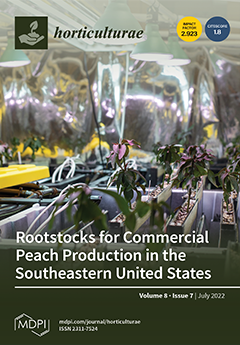In this study, we analyzed and compared the concentrations of selected metals/metalloids and the antioxidant response of
Salix alba L. (white willow) bark in the highly polluted area around the Kosovo A and B thermal power plants. The antioxidant capacity of
Salix alba bark was evaluated in terms of the total phenolics, flavonoids, chlorophylls, and carotenoids, while the metal content in the soil and willow bark was analyzed by ICP-OES (inductively coupled plasma optical emission spectroscopy). For total antioxidant level assessment, FRAP, DPPH, and CUPRAC assays were conducted. The mean concentrations of selected elements in soil and willow dry mass range from 15,698.4 mg kg
−1 dry mass (soil) to 371.1 mg kg
−1 (willow bark) for Al; 37.676 mg kg
−1 (soil) to <2 ppb (willow bark) for As; 14.8 mg kg
−1 (soil) to 0.62 mg kg
−1 (willow bark) for Cd; 24.2 mg kg
−1 (soil) to 1.2 mg kg
−1 (willow bark) for Cr; 58.8 mg kg
−1 (soil) to 9.1 mg kg
−1 (willow bark) for Cu; 16,975.68 mg kg
−1 (soil) to 385.4 mg kg
−1 (willow bark) for Fe; 95.0 mg kg
−1 (soil) to 7.9 mg kg
−1 (willow bark) for Ni; 185.2 mg kg
−1 (soil) to <1 ppb (willow bark) for Pb; and 226.7 mg kg
−1 (soil) to 87.7 mg kg
−1 (willow bark) for Zn. Additionally, the
Salix alba bark samples presented mean values of 12,191.6 mg kg
−1 for Ca, 1306.0 mg kg
−1 for Mg, and 123.1363 mg kg
−1 for Mn. The mean phenolic content was 39.292 mg GAE g
−1 DW, being 28.222 mg CE g
−1 DW for flavonoids, 38.099 mg g
−1 FW for CHLa, 49.240 mg g
−1 FW for CHLb, and 94.976 mg g
−1 FW for CAR. The results of this study indicate that the bark of
Salix alba contains significant amounts of phenolic compounds, and strong positive and moderate negative correlations are revealed between total phenolic compounds and iron, and total phenolics and nickel and manganese, respectively.
Full article





